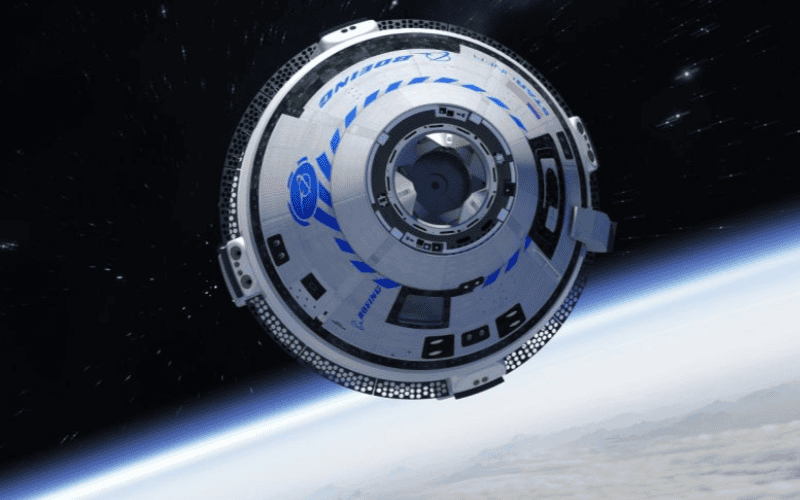
The first trip to orbit by Boeing’s CST-100 Starliner crew capsule will be a short one.
Starliner has been cleared to land Sunday morning (Dec. 22), about 48 hours after launching on an uncrewed demonstration mission called Orbital Test Flight (OFT). OFT was supposed to go to the International Space Station (ISS), but Starliner’s onboard timing system erred shortly after liftoff and the capsule ended up stranded in a low orbit, without enough fuel to make its appointed rounds.
So the mission team has decided to bring Starliner down six days earlier than previously planned, NASA and Boeing representatives announced today (Dec. 21). The touchdown will take place at the originally targeted site, the U.S. Army’s White Sands Missile Range in New Mexico, at 7:57 a.m. EST (1257 GMT) Sunday. You can watch the action live here at Space.com, courtesy of NASA; coverage begins at 6:45 a.m. EST (1145 GMT).
Boeing’s OFT mission was designed to show that Starliner is ready to carry NASA astronauts to and from the ISS. Boeing has been developing the capsule with the help of funding from the space agency’s Commercial Crew Program — most notably, a $4.2 billion contract announced in September 2014. SpaceX got a similar deal worth $2.6 billion to complete work on its Crew Dragon capsule (which aced its version of OFT this past March.)
NASA is counting on these private vehicles to end the agency’s dependence on Russian Soyuz spacecraft, which have been the only astronaut ride to and from orbit since the U.S. space shuttle fleet was retired in July 2011.
OFT got off the ground in fine form, enjoying a nominal liftoff from its United Launch Alliance Atlas V rocket. But the problem with Starliner’s “mission elapsed timing” system manifested not long into the flight.
The capsule sets its onboard timer by retrieving data from the Atlas V, Jim Chilton, senior vice president of Boeing’s Space and Launch Division, explained during a news conference today.
“Somehow, we reached in there and grabbed the wrong spot,” Chilton said. The issue likely lies with Starliner’s onboard software and seems to be a simple retrieval error, he added.
“So far, it doesn’t look like a major systemic issue,” Chilton said. But he did stress that this is a preliminary diagnosis, and the Starliner team continues to investigate the issue.
The timing problem had major consequences for Starliner and OFT. The capsule thought it was time to start preparing for its big orbit-insertion burn, which would send it on its way toward the ISS, so Starliner began firing its small, reaction-control thrusters to maintain the proper orientation. But it was actually too early in the flight profile to do this, and, by the time the mission team had noticed and fixed the problem, Starliner had burned too much propellant to get to its intended orbit.
Starliner’s handlers had problems sending commands to the spacecraft via NASA’s Tracking and Data Relay Satellites (TDRS), which explains, at least in part, why those troubleshooting attempts came too late, mission team members have said.
It appears that Starliner happened to be in a position between TDRS craft during those crucial moments, making communication difficult, Chilton said today. But Starliner also apparently wasn’t pointing its antenna toward the relay satellites as expected — another issue that likely traces back to the timing problem.
“The mission-elapsed timing challenge is the challenge,” NASA Administrator Jim Bridenstine said during today’s telecon. “If that didn’t happen, this very well could have been a very smooth mission.”
Those challenges notwithstanding, OFT is still providing lots of valuable data for the NASA and Boeing teams, stressed Bridenstine, Chilton and NASA Commercial Crew Program deputy manager Steve Stich, who was also on today’s call.
“The real point of the OFT mission is to learn about the spacecraft and its operations as soon as we can, to set us up for those future crewed flights,” Stich said.
And Starliner has performed very well during its time in orbit, Chilton said: “In space, Starliner has proven to be an able vessel.”
The mission team has also checked off a number of OFT milestones, such as establishing a communications link with the International Space Station and demonstrating its guidance, navigation and control systems in flight. Rendezvous and docking with the orbiting lab is a big objective that will go unmet, of course. But the capsule has extended and retracted its docking system during its laps around Earth, Chilton said.
The two biggest milestones from an astronaut-safety perspective are launch and landing, he added. And Starliner has a chance to go two-for-two in this regard tomorrow morning with a soft, parachute-aided touchdown in the New Mexico desert.
“Tomorrow is a really big day,” Bridenstine said. “We have to be on our A game.”
If some issue pops up an scuttles the early-morning entry, descent and landing attempt, Starliner has a backup window, also at White Sands, about 8 hours later, Chilton said.
The capsule performed two engine burns yesterday (Dec. 20), raising and reshaping its orbit to a circular one with an altitude of 155 miles (250 kilometers). The ISS circles Earth at an average height of about 250 miles (400 km).
Visit Space.com Sunday, Dec. 22, for complete coverage of Starliner’s OFT landing at White Sands Space Harbor, New Mexico.
